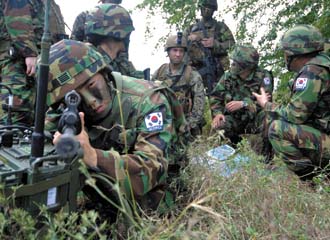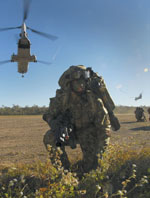Practice Makes Perfect
 |
Korean Sgt. Beom Kim stands watch as 31st Marine Expeditionary Unit Marines and Republic of Korea marines review a map during a simulated amphibious assault as part of exercise Cobra Gold. Cobra Gold is a regularly scheduled joint and multinational exercise hosted annually by the Kingdom of Thailand and designed to enhance interoperability among the United States and Pacific nations. |
Operating from the most remote island chain on the planet, the U.S. Pacific Command is working to bridge the waters that surround it by training hard and often with countries in the Asia-Pacific region. In an area of responsibility where bilateral relationships rather than multinational alliances are the norm, personnel spend large amounts of time engaged in exercises designed to improve interoperability and promote peace. Each year command troops and civilians alike rehearse, sometimes with tens of thousands of their closest friends, for real-world emergencies while simultaneously establishing relationships with their neighbors to the east.
According to Pacific Command (PACOM),
Constant exercising ensures that partners’ capabilities work together. The actions also help create continuity in an environment where personnel constantly change. Individuals moving into and out of the command create a need to introduce new people to each other on a regular basis. Through the exercises, nations can ensure that whenever disaster strikes or conflict arises, the personnel responding are prepared and have prior relationships with one another.
The people involved change often, but the exercises themselves do not. Cmdr. Aber explains that the events scheduled usually remain consistent, though some are held biennially, and that during his two-year PACOM tenure no exercises have been added or removed. However, he explains, “We’re always looking for opportunities to expand our exercise program.” With a large area of operations encompassing 36 countries, the command is eager to interact with partners when it can.
The many exercises held by the command have different themes, such as warfighting or disaster response. In an environment fraught with natural threats including volcanoes, earthquakes and cyclones, disaster readiness is a major element, and Cmdr. Aber says in any given exercise at least one vignette focuses on response efforts.
Some of the exercises cover a broad scope of activities; others are more specialized. Cmdr. Aber explains that while many of the training events include tactical forces and the actions they would need to take to secure an area and help the people in it, others focus only on high-level leaders at the combatant command and operational levels. These include exercises that are exclusively tabletop events with no field component.
In other exercises, the line between practice and reality blurs. During certain events, participants practice their disaster response efforts by providing actual aid to people who need it. The almost constant presence of humanitarian problems in the region also means that partner countries have plenty of opportunity to gain real-world experience. A source of friction in the PACOM area of responsibility (AOR) is the need to balance missions and training. Disasters and other events trump exercises, so if a problem crops up in the middle of an event, participants are diverted to respond.
To guide all the different exercises and activities, PACOM officials reference the Pacific Joint Training Strategy, which lays out the focuses, such as allied engagement or capacity building, for the different events. Exercises with developed, capable partners, for example, might focus closely on readiness because basics already are in place.
PACOM exercises vary in size. According to the command, its largest, Talisman Saber, involves 24,000 individuals. Because the event trains from the top echelons down to the bottom for contingency operations, it requires a significant number of participants. This effort, which involves
The event is always held in
Key Resolve is another large, bilateral exercise that involves many thousands of people. This event takes place between
 |
A soldier from the 3rd Battalion of the Royal Australian Regiment prepares to move after being dropped off at Sam Hill Airfield by a U.S. Marine Corps CH-46 Sea Knight helicopter during exercise Talisman Saber, a biennial combined training activity designed to train Australian and U.S. forces in planning and conducting combined task force operations. |
Though PACOM personnel often exercise in bilateral events, there are exceptions. “Cobra Gold is a perfect example of a multilateral exercise,” Cmdr. Aber says. Cobra Gold began as a Thailand-United States exclusive training event, but it has grown over time. This year, the
Cmdr. Aber says the
In a different type of event, PACOM exercises the ever-necessary humanitarian response skills. For the past five years, command personnel have engaged in Pacific Partnership, an activity that strengthens regional relationships in Southeast Asia and Oceania through medical, dental and engineering aid and prepares the
As with almost every activity undertaken by the
Exercising helps to eliminate bureaucracy because participants can pinpoint who is in charge of particular functions. By doing this ahead of an actual event, responders know whom to contact or mobilize, eliminating layers of confusion. The events have to be challenging for participants if they are to derive real benefit. “When you present the training audience with complex scenarios that staff has to work through, they realize where their strengths and deficiencies are,” Cmdr. Aber explains.
Planners try to make all of the training as realistic as possible, and this requires keeping an eye on world events. Exercises aim to enhance force readiness, meaning that troops need to be prepared to meet current threats, whether caused by humans or nature. When necessary, alterations even can be made midstream. “We have the flexibility to change the scenario,” Cmdr. Aber explains. During the exercise life cycle, changes evolve and sometimes are mandated. The commander says that in certain cases senior directors weigh in late to express the need for alterations to accommodate developing events or frictions.
Another factor that affects planners’ jobs and schedules is the PACOM headquarters’ distance from the other nations in its AOR. With the international dateline running between
The engagement pieces of the exercises are part of the PACOM campaign strategy to reach out to nations in the Asia-Pacific region. Representatives meet consistently with partner nations not only in military-to-military venues but also often with civilian agencies. The increased interaction between the
He adds that the impact of these exercises is huge for all the echelons from the commander of PACOM down to tactical units, ships, sailors and troops on the ground. In addition, building capability and capacity in partner nations enhances future interactions. Exercises also enable the
Finally, the exercises promote stability and security with the region, and PACOM is striving to make the area more peaceful. By engaging in both military and humanitarian exercises,
WEB RESOURCES
Pacific Command: www.pacom.mil
Australian Department of Defence: www.defence.gov.au
Japan Ministry of Defense: www.mod.go.jp/e/index.html




Comments